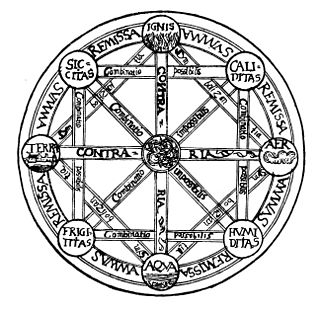
The classical elements typically refer to earth, water, air, fire, and (later) aether which were proposed to explain the nature and complexity of all matter in terms of simpler substances. Ancient cultures in Greece, Angola, Tibet, India, and Mali had similar lists which sometimes referred, in local languages, to "air" as "wind", and to "aether" as "space".
Air or Wind is one of the four classical elements along with water, earth and fire in ancient Greek philosophy and in Western alchemy.

Physical science is a branch of natural science that studies non-living systems, in contrast to life science. It in turn has many branches, each referred to as a "physical science", together is called the "physical sciences".

Robert Fludd, also known as Robertus de Fluctibus, was a prominent English Paracelsian physician with both scientific and occult interests. He is remembered as an astrologer, mathematician, cosmologist, Qabalist, and Rosicrucian.

Hermeticism, or Hermetism, is a philosophical and religious tradition rooted in the teachings attributed to Hermes Trismegistus, a syncretic figure combining elements of the Greek god Hermes and the Egyptian god Thoth. This system encompasses a wide range of esoteric knowledge, including aspects of alchemy, astrology, and theurgy, and has significantly influenced various mystical and occult traditions throughout history. The writings attributed to Hermes Trismegistus, often referred to as the Hermetica, were produced over a period spanning many centuries and may be very different in content and scope.

Astral projection is a term used in esotericism to describe an intentional out-of-body experience (OBE) that assumes the existence of a subtle body, known as the astral body or body of light, through which consciousness can function separately from the physical body and travel throughout the astral plane.

A subtle body is a "quasi material" aspect of the human body, being neither solely physical nor solely spiritual, according to various esoteric, occult, and mystical teachings. This contrasts with the mind–body dualism that has dominated Western thought. The subtle body is important in the Taoism of China and Dharmic religions such as Hinduism, Buddhism, and Jainism, mainly in the branches which focus on tantra and yoga, where it is known as the Sūkṣma-śarīra. However, while mostly associated with Asian cultures, non-dualistic approaches to the mind and body are found in many parts of the world.
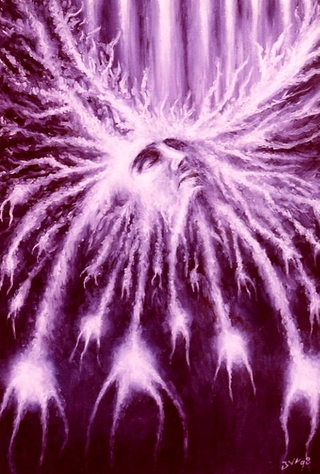
The astral body is a subtle body posited by many philosophers, intermediate between the intelligent soul and the mental body, composed of a subtle material. In many recensions the concept ultimately derives from the philosophy of Plato though the same or similar ideas have existed all over the world well before Plato's time: it is related to an astral plane, which consists of the planetary heavens of astrology. The term was adopted by nineteenth-century Theosophists and neo-Rosicrucians.

The astral plane, also called the astral realm or the astral world, is a plane of existence postulated by classical, medieval, oriental, esoteric, and New Age philosophies and mystery religions. It is the world of the celestial spheres, crossed by the soul in its astral body on the way to being born and after death, and is generally believed to be populated by angels, spirits or other immaterial beings. In the late 19th and early 20th century the term was popularised by Theosophy and neo-Rosicrucianism.
In esoteric cosmology, a plane is conceived as a subtle state, level, or region of reality, each plane corresponding to some type, kind, or category of being.

The Rosicrucian Fellowship (TRF) was founded in 1909 by Max Heindel with the aim of heralding the Aquarian Age and promulgating "the true Philosophy" of the Rosicrucians. It claims to present Esoteric Christian mysteries or esoteric knowledge, alluded to in Matthew 13:11 and Luke 8:10, to establish a meeting ground for art, religion, and science and to prepare the individual through harmonious development of the mind and the heart for selfless service of humanity.
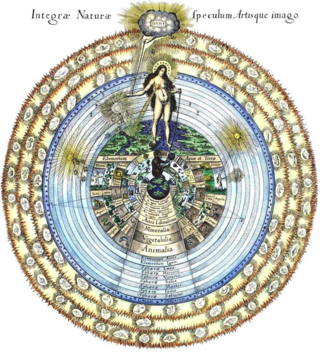
The concept of the anima mundi (Latin), world soul, or soul of the world posits an intrinsic connection between all living beings, suggesting that the world is animated by a soul much like the human body. Rooted in ancient Greek and Roman philosophy, the idea holds that the world soul infuses the cosmos with life and intelligence. This notion has been influential across various systems of thought, including Stoicism, Gnosticism, Neoplatonism, and Hermeticism, shaping metaphysical and cosmological frameworks throughout history.
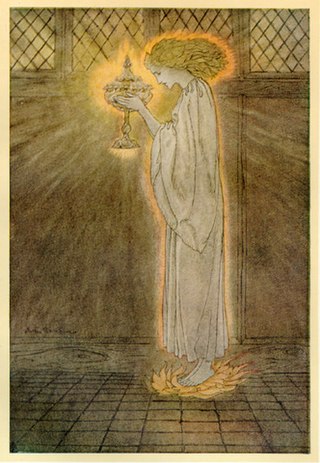
The etheric body, ether-body, or æther body is a subtle body propounded in esoteric and occult philosophies as the first or lowest layer in the human energy field or aura. The etheric body is said to be in immediate contact with the physical body and to sustain it and connect it with "higher" bodies. It is also said to consist of a finer substance, more pure and composed of smaller particles, than the ordinary matter of the physical plane.
The etheric plane is a term introduced into Theosophy by Charles Webster Leadbeater and Annie Besant to represent the subtle part of the lower plane of existence. It represents the fourth [higher] subplane of the physical plane, the lower three being the states of solid, liquid, and gaseous matter. The idea was later used by authors such as Alice Bailey, Rudolf Steiner, Walter John Kilner and others.
According to ancient and medieval science, aether, also known as the fifth element or quintessence, is the material that fills the region of the universe beyond the terrestrial sphere. The concept of aether was used in several theories to explain several natural phenomena, such as the propagation of light and gravity. In the late 19th century, physicists postulated that aether permeated space, providing a medium through which light could travel in a vacuum, but evidence for the presence of such a medium was not found in the Michelson–Morley experiment, and this result has been interpreted to mean that no luminiferous aether exists.

Platonism is the philosophy of Plato and philosophical systems closely derived from it, though contemporary Platonists do not necessarily accept all doctrines of Plato. Platonism has had a profound effect on Western thought. At the most fundamental level, Platonism affirms the existence of abstract objects, which are asserted to exist in a third realm distinct from both the sensible external world and from the internal world of consciousness, and is the opposite of nominalism. This can apply to properties, types, propositions, meanings, numbers, sets, truth values, and so on. Philosophers who affirm the existence of abstract objects are sometimes called Platonists; those who deny their existence are sometimes called nominalists. The terms "Platonism" and "nominalism" also have established senses in the history of philosophy. They denote positions that have little to do with the modern notion of an abstract object.
An astral spirit is a term used in spiritualism and holism and can be described as having a demonic influence and existing in space with no physical body. The Astral Spirit exists in what is called the Astral Plane. Depending on the time period and culture, the term can have several meanings. It was thought to be one of the three parts of the human soul that contained the "thoughts, cogitations, desires, imaginations that were impressed upon the mind at the time of death" as well as lust and anger. Philosopher's had different viewpoints and ideas of the Astral Spirits as Marsilio Ficino considered it to be a link between the physical body and soul, while others such as Jean Fernel associated it more with animal spirits. Philosopher Henry More introduced the term into the medical setting and considered the astral spirit to be a part of the body that was separate from the "rational soul" and viewed it as the "seat of impulses". He believed that man was responsible still for controlling these impulses and enthusiasm. Astral spirits have also been associated with spirit and witchcraft, specifically black magic, and was considered to be demonic in origin at one point. The term was also used in relation to the concept of ghosts and vampirism in the nineteenth century.
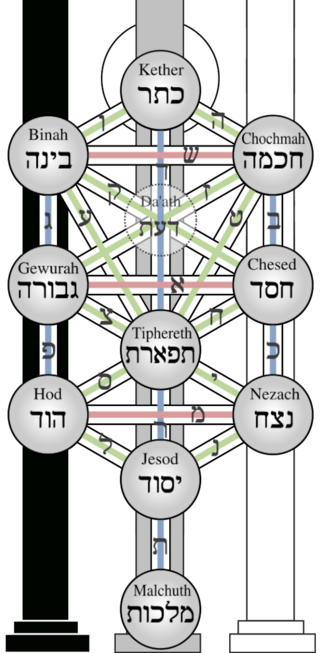
The tree of life is a diagram used in Rabbinical Judaism in kabbalah and other mystical traditions derived from it. It is usually referred to as the "kabbalistic tree of life" to distinguish it from the tree of life that appears alongside the tree of the knowledge of good and evil in the Genesis creation narrative and well as the archetypal tree of life found in many cultures.

The body of light, sometimes called the 'astral body' or the 'subtle body,' is a "quasi material" aspect of the human body, being neither solely physical nor solely spiritual, posited by a number of philosophers, and elaborated on according to various esoteric, occult, and mystical teachings. Other terms used for this body include body of glory, spirit-body, luciform body, augoeides, astroeides, and celestial body.
Within Thelema, the Great Work is the spiritual endeavor aimed at realizing one's True Will and achieving a profound mystical union with Nuit, the Thelemic personification of the infinite and boundless expanse of the universe. This path, crafted by Aleister Crowley, draws inspiration from Hermetic alchemy and the Hermetic Qabalah. The cornerstone of Thelema is the Book of the Law, received by Crowley in 1904 through a communication with the entity Aiwass. This text became the central scripture, heralding a new Aeon for humanity and outlining the principles of Thelema.













